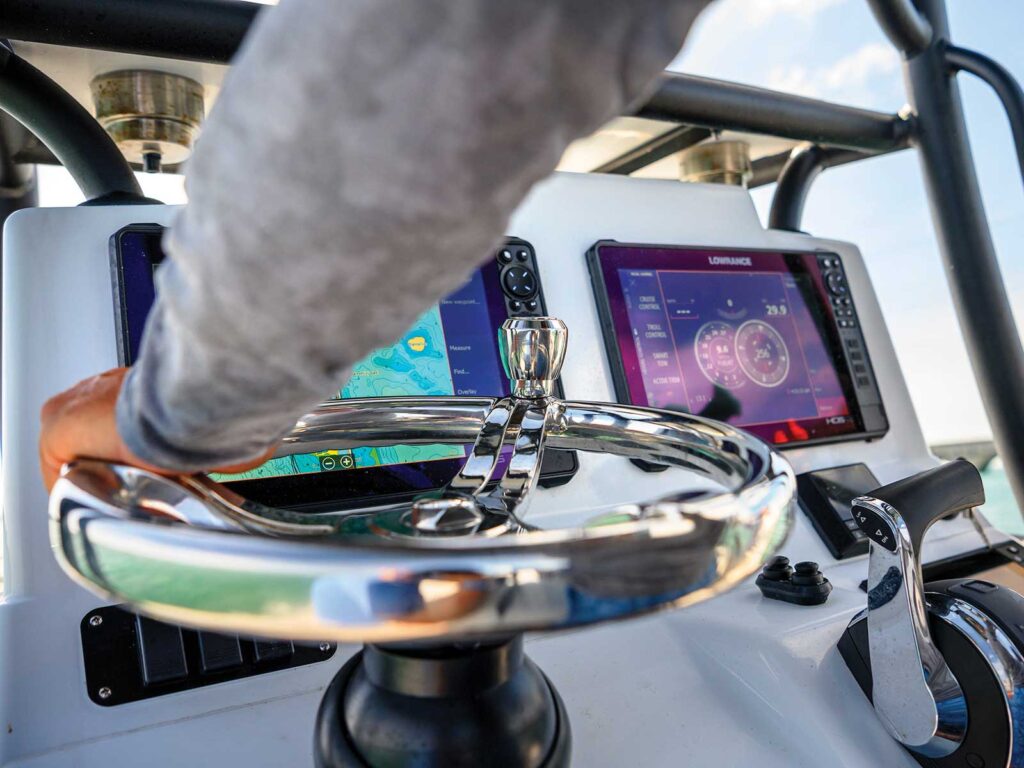Wide-Screen vs. Standard MFDs
 Multifunction displays serve as important angling tools. Choosing the right screens for your new boat can prove critical to fishing success.
Jason Stemple
Multifunction displays serve as important angling tools. Choosing the right screens for your new boat can prove critical to fishing success.
Jason Stemple
While many marine electronics units are becoming more compact these days, marine multifunction displays are headed in the opposite direction. Like today’s television flat screens, touchscreen displays are growing ever larger, with some brands offering screens as expansive as 27 inches or greater. And of course, the larger the screen, the easier it is to read and interpret various MFD functions such as a chart plotter, sonar, radar, and more.
MFDs are also getting proportionately wider. The aspect ratios—the relationship between the screen width and height—are increasing. This is exemplified by 16-inch (diagonal) models such as the Garmin GPSMap 1643xsv and Humminbird Apex 16 Mega SI+, both of which feature wide screens that are 1,920 pixels wide by 1,080 pixels tall. That equates to an aspect ratio of 1.77-to-1.
Simrad has taken the wide-screen MFD even further with its NSX Ultrawide series, available in 12- and 15-inch models. These models feature displays that are 1,920 pixels wide by 720 pixels tall, resulting in 2.66-to-1 aspect ratio. To give you an idea of the difference, the touchscreen on the standard 12-inch Simrad NSX measures 1,280 pixels wide by 800 pixels tall—a 1.6-to-1 ratio.
So, what does this have to do with boat buying? When you order a new saltwater fishing boat, you often have the opportunity to option it with your choice of marine electronics, either direct from the factory, through your boat dealer, or through a qualified marine-electronics installer.
In any of these cases, one of the most critical decisions will be which MFD(s) you spec out for your new boat, and part of the process might boil down to choosing between a wide-, ultrawide- and standard-format display. Here are factors to help you make the best selection.
Dash SpaceThe physical space you have available at the helm will play heavily in your decision. Most MFDs on today’s new fishing boats are flush-mounted into the dash area rather than bracket-mounted. Flush mounting results in a clean and professional-looking installation that hides all of the wires and cable behind the dash.
Let’s say the helm of your new boat has a space measuring 20-by-8 inches available for flush mounting one or more displays, and you’re leaning toward a Simrad system. With this in mind, one choice would be a single 16-inch NSX Ultrawide that requires a space of 15.55-by-6.71 inches. Another choice might be a pair of standard-format NSX 9-inch MFDs, each requiring 9.4-by-5.85 inches.
Either of these MFD configurations will fit the space in this example, but the choice will hinge on additional factors, as detailed below.
FunctionsToday’s MFDs prove marvelous for centralizing control and monitoring of onboard systems via NMEA-2000 networking. However, the number of functions you need to control at once might help determine the MFD configuration you choose.
To illustrate the point, let’s continue using the Simrad example. With the 15-inch NSX Ultrawide, the screen can be split up to four times, allowing you to monitor a quartet of functions at a glance. You can quickly and easily change the screen to other functions, but four is the maximum at one time.
With the NSX 9-inch, the maximum number of screen splits is four as well. Yet, with a pair of these MFDs, you can monitor up to eight functions simultaneously. Again, you can quickly call up other functions on the display, but eight is maximum at any given time.
CostSo, what is the cost difference in our comparison example? The MSRP for the 15-inch NSX Ultrawide (without transducers) is $3,399, while each 9-inch NSX MFD (without transducers) carries an MSRP of $1,449, for a total of $2,898 for a pair. So, the combined retail cost of the two smaller MFDs is less than the single NSX Ultrawide.
Beyond the cost of the units, installation and rigging costs of two displays versus one might be slightly higher, but in this particular example, you will likely still save money with the two standard-format 9-inch NSX displays even after paying for installation.
 A pair of multifunction displays offers the safety of redundancy. If one display fails for any reason, you have a backup unit to help get you home.
Jason Stemple
Redundancy
A pair of multifunction displays offers the safety of redundancy. If one display fails for any reason, you have a backup unit to help get you home.
Jason Stemple
Redundancy
Another advantage to having a pair of MFDs is redundancy, and that’s why you see many new saltwater fishing boats with two or more displays on the dash. Should one MFD become damaged, malfunction or fail for any reason, you have another available for monitoring and controlling critical onboard systems, navigating, and finding fish.
VisualizationIs the extra cost of a wide or ultrawide display worth it? The more expansive view is certainly worth considering. As Simrad puts it: “The NSX Ultrawide provides a more streamlined and immersive experience, resulting in an elevated dash aesthetic that unlocks new possibilities.” Visually, the panoramic view of wide and ultrawide displays is akin to seeing a film in IMAX versus a standard movie screen with a conventional MFD.
While you might not have the same number of split screens available as outlined in our comparison against a pair of 9-inch displays, there’s another factor to consider. A wide or ultra- wide MFD in split-screen mode makes you feel like you there are two displays on the dash.
The comparison we use here is just one scenario in a wide array of boat-buying possibilities. But try applying some of these same factors to your particular situation. When it comes to marine electronics for your new boat, they can help you in deciding on the MFD configuration that’s right for you and your style of fishing.
The post Wide-Screen vs. Standard MFDs appeared first on Salt Water Sportsman.
- Home
- About Us
- Write For Us / Submit Content
- Advertising And Affiliates
- Feeds And Syndication
- Contact Us
- Login
- Privacy
All Rights Reserved. Copyright , Central Coast Communications, Inc.